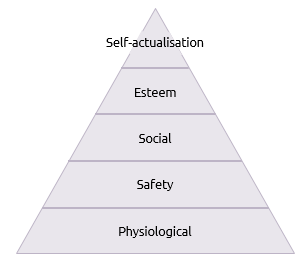Abraham Maslow proposed his hierarchy of needs in 19431. The theory has been widely accepted and quoted even though Maslow never did any empirical research to support it.
The hierarchy shows a progression of motivational factors. It starts at basic human survival and progress to higher intellectual needs. The hierarchy starts with basic physiological needs such as food, water, oxygen, exercise. It then progresses through another four levels culminating with self-actualisation which is about satisfying yourself that you have fulfilled your potential. As each of these needs is satisfied it ceases to become a motivator.
 Only needs that have yet to be satisfied are motivational but as with all models of human behaviour, this initial theory is sound, generally true, but simplistic. Maslow himself identified a number of exceptions:
Only needs that have yet to be satisfied are motivational but as with all models of human behaviour, this initial theory is sound, generally true, but simplistic. Maslow himself identified a number of exceptions:
-
Some creative people can be motivated by the higher needs in spite of the fact that lower ones remain unsatisfied. The image of the absent minded professor who forgets to eat when absorbed in his work is a classic stereotype
-
If someone has a narrow life experience their aspirations will be correspondingly low and they do not feel motivated to reach the higher levels
-
With some very idealistic people (with strong political, religious or philosophical values) their need to maintain these values can override other needs
-
Once somebody has progressed to higher needs, those will continue even if lower level needs suddenly become unsatisfied
In P3 Management terms the levels could be interpreted as:
| Maslow level | Business interpretation | P3 environment |
|---|---|---|
Level 1 | Salary, good working environment. | While a P3 Manager in a matrix organisation rarely has control over pay and rations they can establish a good working environment. |
Level 2 | Safe working conditions and job security. | It is a P3 manager’s responsibility to ensure a safe working environment within the confines of the project or programme but job security is not so easy. Projects and programmes are transient and so have a certain built-in ‘job-insecurity’. P3 managers must be aware of this as someone’s time on the project or programme comes to an end. |
Level 3 | Good team atmosphere, friendly supervision. | At the higher levels, the P3 manager has more influence. Teamwork and leadership are very much part of the P3 manager role and this is where Maslow resonates with models such as Tuckman and Hersey & Blanchard. |
Level 4 | Recognition of achievements. | Projects and programmes are all about overcoming the inevitable problems to deliver objectives. If members of the management and delivery teams achieve objectives, what better environment is there to be able to recognise that fact? |
Level 5 | Opportunities for creativity, personal development and promotion. | While it may not be in the P3 manager’s gift to offer promotion a project or programme should definitely be an opportunity for personal development and an expression of creativity. |
- Maslow, A.H. (1943). A theory of human motivation. Psychological Review, 50(4), 370–96.





